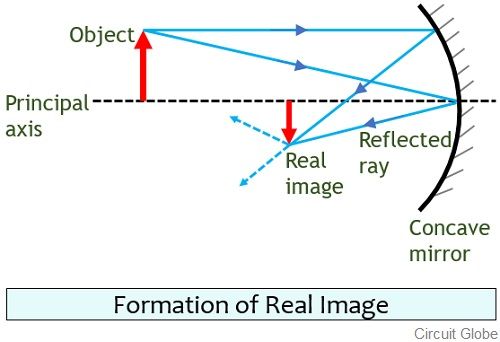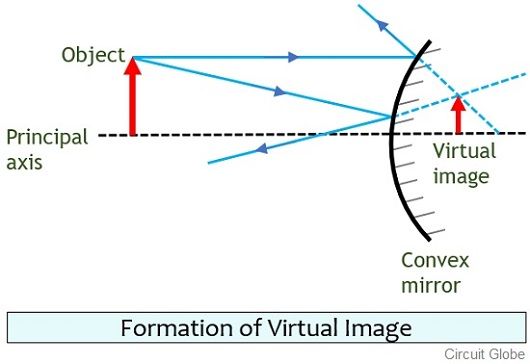Real image and virtual image are the two classifications of the image that is formed by reflection or refraction of light rays. The crucial difference between the real image and a virtual image is that real images are formed when light rays actually meet at a point after getting reflected or refracted from a mirror. As against virtual images are formed in the case when light rays appear to meet at a point in the vicinity beyond the mirror.
This means in the case of the virtual image it is assumed that light rays have met at a particular point in the backward region of the surface where the image is getting formed. More simply, we can differentiate the two as the real images can be displayed on the screen but the virtual image can never be displayed on the screen.
What is an image?
Basically, an image is a visual representation of an object which is placed somewhere in front of a mirror or lens. The formation of the image is a result of the meeting of light rays after being reflected or refracted according to their respective laws.
It is to be noted here that rays not always meet, sometimes they just appear to meet. This also produces images. So, on the basis, that either the rays actually meet or just appear to meet, images are classified as real and virtual. As the two types of images are produced in a different manner thus holds various differentiating factors which we will discuss in this content.
Content: Real Image Vs Virtual Image
Comparison Chart
| Basis for Comparison | Real Image | Virtual Image |
|---|---|---|
| Basic | These are formed in the front side of the mirror. | These are assumed to be formed at the backside of the mirror. |
| Type of lens used | Converging | Diverging |
| Image reception | Image can be appeared on a screen. | Image appears to be on the mirror or lens itself. |
| Interaction of light rays | Actual | Imaginary |
| Appearance of image | Inverted | Erect |
| Formed by | Concave mirror and convex lens. | Plane, convex mirror and concave lens. |
| Example | Image on the theater screen. | Reflection of any object or body on plane mirror. |
Definition of Real Image
Real images are the type of images that are formed due to the convergence of light rays at a point after being reflected or refracted from a mirror or lens. Real images are formed at the point where light rays undergo interaction with each other. Real images are inverted in nature and can be seen on the screen.
Suppose an object is placed in front of the concave mirror and light after getting reflected from that object strikes the surface of the concave mirror. When multiple light rays strike the mirror, then by following the laws of the reflection, the light different rays again get reflected and meet at a point in front of the mirror.
The figure below represents the formation of a real image:
As we can see here that light rays actually get focussed at a certain position. And at that particular position, a visible image of that object is formed. It is to be noted here that after converging at a point, the rays get diverged from that particular point.
Definition of Virtual Image
Virtual images are the images that only appear to be formed at a position behind a mirror. However, in actuality, the image is not present there. Unlike the real images, a virtual image is formed when reflected or refracted light rays get diverged. In this case, when light from an object is allowed to strike the mirror and when light rays get reflected from the mirror then it looks like that the rays are diverging somewhere behind the mirror.
The figure below represents the above-discussed phenomenon:
Basically, no light reaches the behind the mirror, thus it is always said that rays appear to meet somewhere, as it is simply the perception of the viewer. This is the reason why virtual images are not displayed on the screen. The images produced in the case of plane mirrors are specifically of virtual type.
Another noteworthy point over here is that virtual images are not imaginary. Thus possess definite shape and size and hence can be seen by the eye or any optical instrument.
Key Differences Between Real and Virtual Image
- Real images are formed when light rays after reflection or refraction converge at a point before a mirror or lens. While virtual images are formed when the light rays diverge after reflection or refraction.
- Real images appear on the screen as against virtual images never appear on the screen.
- Converging types of lenses are used to produce a real image. Whereas a diverging lens is used for the formation of virtual images.
- Real images are inverted in nature. While virtual images appear erect.
- Generally, concave mirrors or convex lenses form real images. Plane mirror, convex mirror, and concave lens are regarded as the virtual image forming surfaces.
- The front region of the mirror forms real images. Whereas virtual images are assumed to be formed behind the mirror.
- Real images are formed due to the actual interaction of real rays. However, virtual images are formed when light rays imaginarily interact with each other.
- In the case of the real image, the light rays diverge from the same side of the mirror after converging and forming the real image. While in the case of the virtual image, the light rays assumed to diverge from a point somewhere behind the mirror.
Conclusion
So, from this discussion, we can conclude that real and virtual images are categorized on the basis of their formation, as one is formed on the screen while the other on the mirror itself.


